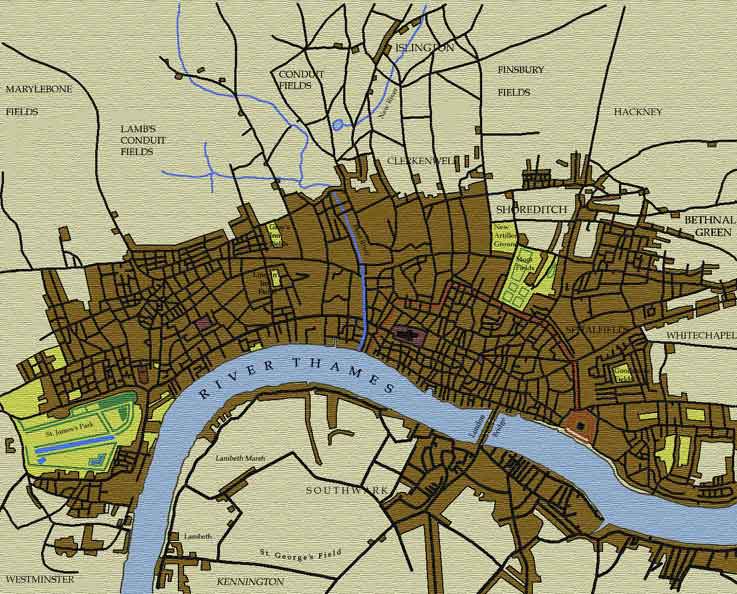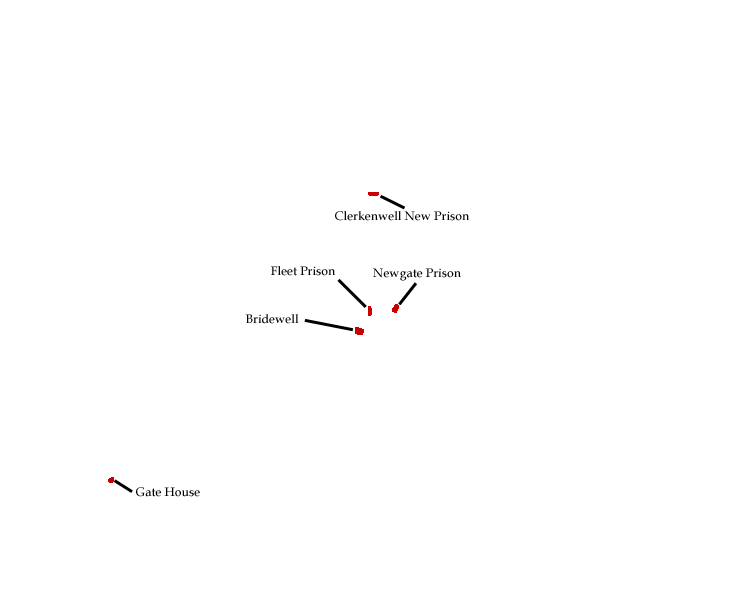|
London was, amongst many other things, a city of
crime and poverty; it is not surprising, then, that its many prisons should
feature so prominently in the literature and literary history of the Restoration
and eighteenth-century. One important reason for this prominence is the
fact that a great many "offences" now not deemed to be so, or
not considered serious enough for imprisonment, could lead to incarceration:
bankruptcy, debt, and vagrancy are the most important examples. Given
that London abounded in all of these facets of life, the existence, by
1800, of no less than 18 prisons in London, serving a variety of clientele,
seems understandable.
|
|
Conditions in eighteenth-century prisons
were, by modern standards, horrendous: most prisons were filthy and overcrowded,
and little attention was paid to the welfare of the imprisoned. Drunkenness
and gambling were rife within the walls of these places, and violence
and disease took a terrible toll of the inmates. Of course, conditions
need not be so poor for those willing and able to supplement the jailor's
income with an unofficial stipend; ready money could buy a certain degree
of luxury. Extortion from jailors seems to have been customary, and the
experiences of Macheath, and venality of Lockit, in John Gay's Beggar's
Opera were probably the rule.
Bridewell
Built on the site of a Norman palace in 1523 as an appropriately magnificent
accommodation for the visiting Emperor Charles V, Bridewell was gifted
to the City by Edward VI in 1553; it was to serve as a workhouse for the
poor, and as a prison for vagabonds, prostitutes, disobedient apprentices,
and the generally indigent. Prisoners were employed picking oakum and
beating hemp. Ironically, the prison apparently began to attract the poor
from the areas surrounding London, who actually moved to the City in order
to take up residence in the institution. Alarmed, the citizenry of London
protested, and Bridewell began service instead as a storage house for
grain in the early seventeenth century. By the Restoration, however, the
building was once again being employed as a prison, and seems, again,
to have been reserved for prostitutes, the poor, and others whose sentences
were of relatively short duration. It was destroyed in the Great Fire
of 1666, and was rebuilt two years later in an even grander manner than
that of the previous edifice. Bridewell's prominent position in the daily
life of London is testified to by the frequency with which references
to the prison appear in the literature of the period; it also serves as
the setting for the fourth panel of William Hogarth's The Harlot's
Progress.
Newgate
Newgate Gaol (i.e., Jail) was originally housed in the gatehouse on the
London wall that went by that name, a function it had fulfilled since
at least the twelfth century; the gatehouse itself dated from the same
century. It was rebuilt in the fifteenth century (by the Lord Mayor, Dick
Whittington), and repaired in the mid-sixteenth and early seventeenth
centuries, only to be destroyed during the Great Fire of 1666. Rebuilt
in 1672, it was finally taken down in 1767. Newgate functioned as the
City's primary prison, and the original gatehouse seems to have been sufficiently
large for this purpose until the reign of Charles II; by the eighteenth-century,
however, the prison was terribly overcrowded. A magnificent and imposing
new prison, designed by George Dance the younger, was built between 1770
and about 1783; it was damaged during the Gordon Riots when it was attacked
by the London mob; it was finally demolished in 1902.
Conditions within this prison were, by all accounts,
terrible. Paradoxically, too, it was rife with crime: there were complaints,
for example, that forgers were at work within the actual prison walls
in 1669. The prison, it should be noted, was a frequent destination for
visitors to London, for one could pay for admission to view the condemned
within awaiting execution.
Fleet Prison
Although its origins are somewhat obscure, it is certain that the Fleet
Prison dates from at least Norman times. Destroyed in the Great Fire in
1666, it was rebuilt, only to be destroyed again in the Gordon Riots.
A reference to the prison in the London Gazette in January of 1671
suggests that this building contained about 150 rooms. Following the Gordon
Riots, it was rebuilt yet again in 1781-82.
Before the Civil Wars, the Fleet Prison seems to
have largely been reserved for those committed by the Court of the Star
Chamber, a prerogative court that was abolished just prior to the outbreak
of the First Civil War. From the Restoration, therefore, it was primarily
used as a debtors prison, and for bankrupts. It was certainly to this
capacity that the Fleet Prison owes most of its literary associations:
William Wycherley was imprisoned here for 7 years for debt; the early
eighteenth-century poets Elizabeth Thomas and Richard Savage served time
here as well for the same reason.
Gate House
Gate House lay near the west end of Westminster Abbey, and served as the
chief prison for the Westminster Liberties. Pepys was briefly imprisoned
here in 1690 upon suspicion of harbouring Jacobite sympathies.
Clerkenwell
Clerkenwell, or the "New Prison," was first established in the
seventeenth-century; it was rebuilt in 1775, and again in 1818. A fourth
prison on the site, dating from 1845-46, was finally closed in 1877.
|



